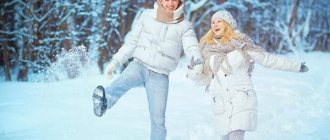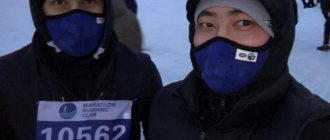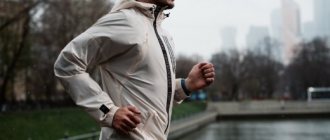On the calendar, the last month of autumn is November, and this means that the entire running community is preparing to be divided into three unequal parts: some will move their vigorous activity to warm, indoor athletics arenas or fitness centers, others will move to the side cross-country skiing, a small part will completely abandon cross-country training until spring, and another part will continue to run in the winter as if nothing had happened, not wanting to change their usual training style to anything else. The main factor in the “separation” and migration of part of the running audience to warm rooms is the weather, which is not comfortable for a large number of runners: cold, wind, precipitation. But these obstacles can be successfully dealt with, and our article will help you in this matter.
Both during the off-season and in winter, one of the basic rules that must be adhered to when purchasing running equipment is the “layering” principle. Moreover, if in the fall and spring you can sweat and, having frozen, wait for some time until it warms up, then in winter the consequences of being in a wet state on the street will be much more unpleasant: from banal serious freezing to frostbite and colds. That is why the selection of base layers for active activities in winter must be approached with special responsibility.
The “first” layer is responsible for removing moisture from the body and keeping your skin dry. Even if cold air penetrates under your clothes, if the moisture is removed from the body, you will never freeze.
The “second” layer retains heat, absorbs and retains the moisture that was removed from the body by the first layer.
“Third layer” - protects from wind, cold, precipitation.
Depending on the weather, the temperature “overboard”, the strength of the wind and the presence of falling or freshly fallen snow, you need to select the thickness of the “layers” and their number: if the weather is closer to 0C, then a minimum of three thin layers will be enough: thermal underwear, thin fleece, windproof jacket, hat, gloves, but if the thermometer drops below -10C, then you should definitely think about increasing the number of layers and maximizing the presence of insulation and structural parts that retain heat near the body.
Special requirements for “winter” clothing and running shoes
A light weight
Many layers - a lot of weight. But no. If you don’t want to look like a beefy penguin at the zoo, then choose clothes for training in winter from the “running” collections - they take into account the fact that you should be warm and that you will need to actively move.
Thermal insulation
Winter “running” collections must have insulation; it is used in an amount sufficient to protect the owner from freezing. At the same time, the insulation layer and the design of the clothing are such that you do not overheat even during intense workouts. To compensate for overheating, it is recommended to use clothing with built-in additional ventilation with zippers that can be opened when you are too hot.
Wind protection
There will be an icy wind and you will definitely need protection from it. That is why collections of clothes and shoes for winter always contain special fabrics and membranes that protect from the wind.
Visibility in the dark
Sports activities in winter often end in the dark. This means that there is a need for your safety to be clearly visible at dusk. Special inserts and applications of reflective paint also predominate in weight and volume in the “winter” collections.
Quick drying and waterproof
Membranes, dense fabrics, thermal insulation materials that absorb moisture well, waterproof zippers, and water-repellent impregnation are mandatory elements. They should protect the runner well from precipitation and piercing winds, dry quickly from body heat and prevent freezing.
Good adhesion to slippery surfaces
This applies, first of all, to sneakers, which should “hold” their owner well on dense snow and ice.
What determines the choice of running clothes?
We would like to dwell in more detail on the point that you should not look for a universal solution when choosing sportswear for winter running. It is always necessary to evaluate the totality of factors influencing the choice of equipment for a specific training or competition. The point is that clothes designed for running at zero temperatures will not be effective when jogging at -20°C, just like vice versa. Likewise, shoes designed for one surface, such as dry asphalt, are not suitable for trail running and are not suitable for running on snow. But high-tread shoes designed for mountains are absolutely not suitable for running on asphalt. In other words, for each thermometer value and each running route there is its own equipment that works as efficiently as possible.
As you know, visual information is remembered much better, so we have presented a hint table for you that will help you navigate when choosing clothes in the temperature period from +10°C to -20°C, taking into account weather conditions, be it sun, wind or precipitation . Do not forget that the final choice is always yours, because only you know the characteristics of your body.
Some may be outraged when looking at the table, because the extreme temperature value is -20 °C. Indeed, there is a category of particularly tough runners who do not consider an air temperature of -30°C to be a serious reason to cancel a workout. In fact, the equipment for these temperature ranges will not differ much from each other.
We can’t help but note that many experts do not recommend running outside in extremely low temperatures of -30°C. However, everyone is free to make their own decisions.
The table above is suitable for most runners and is a fairly accurate representation of the required clothing for each period indicated.
Socks and knee socks
The requirements for socks and knee socks for the winter period are very simple: they must be thicker, warmer than socks and knee socks for the off-season and summer and higher, i.e. reach the top of the calf.
Tight fit. Socks should not move even minimally on the leg. A tight fit should not restrict the freedom of movement of the toes - usually an elastic insert is made in this area that fits the foot tightly. The “elastic band” should not pinch the leg in the calf area.
In winter, you should definitely use socks with added wool or artificial fibers for insulation.
Socks - reliable foot protection
Most running shoes lack insulation. Quite often, feet in them simply begin to freeze, and a warm pair of socks only contributes to higher sweating. This is fraught with hypothermia and colds.
This can be avoided by using thermal socks with high shanks. You can choose a pair made from either synthetic material or fine natural wool. You should never wear cotton socks when going for a run. They, as in the case of underwear, will get wet and will not allow sweat and moisture to pass through.
Thermal underwear
Winter is a time for mandatory use of thermal underwear, which wicks moisture away from the body during active running.
Thanks to the right combination of natural and synthetic threads, sweat in such models is easily absorbed and easily evaporates out, the body does not freeze from cold air penetrating under clothes, and thermal underwear does not accumulate an unpleasant odor. Thermal underwear that is properly selected for the training temperature, even if it gets wet, will still keep you warm in cold weather. You can easily find out the comfortable temperature range for using thermal underwear using the information printed on the packaging. For warm weather (from 0 to -5C) use regular models, for cold weather (from -5C and below) - with the addition of merino wool.
Thermal underwear, which uses special antibacterial impregnations and weaves threads in several layers, differs significantly in functionality and if you want a warm and durable thing, it makes sense to buy just such models.
Good thermal underwear is distinguished by the following details:
1. Flat seams are essentially the standard for clothing that comes into direct contact with the skin.
2. Special shape of the cuffs - in order to prevent cold air from penetrating even through small holes to a hot body, in some models of thermal underwear, elastic lycra cuffs are sewn at the ends of the sleeves, often with holes for the thumbs, which also protects the palms of the hands from freezing.
3. Collar – a stand-up collar to protect the throat from the wind. It is advisable to buy models with a stand-up collar that will protect your throat from cold air. If possible, take thermal underwear with a zipper on the collar to quickly adjust the thermal insulation in case of overheating.
4. Inserts made of mesh or thin, elastic fabric for ventilation and inserts made of dense fabric for protection from cold winds. They are needed for greater freedom of movement, greater heat dissipation, in those areas where excess heat and sweat are formed: in the armpits and on the sides of the body, protection from wind in the chest area.
Models of thermal underwear for winter can be viewed here
Insulation layer
After the base layer comes the so-called insulating middle layer. It is designed to make running at temperatures below -10oC comfortable and ensure the proper level of air circulation. Thanks to the latter, the sweat released during a run is immediately “dried”, and the body temperature is maintained at an optimal level without hypothermia.
Thermal underwear is usually worn as an insulating layer that prevents a sharp increase or decrease in body temperature. It can be made of fine wool or synthetic fabric. A product made from natural wool is preferable. Along with its lightness, this material has antibacterial properties.
“Second layer”: fleeces and vests
A mandatory “winter” piece of equipment. Fleeces and vests are an excellent insulation option, a second layer between the jacket and thermal underwear. Depending on the temperature of use and the strength of the wind, you need to choose from thick ones, with thick fabric inserts and windproof membranes, such as Windstopper, to thin fleeces and vests. Insulating vests are convenient to use as an additional thermal insulating layer during active sports and as dry clothing that you can quickly put on immediately after training to avoid freezing.
We recommend that you choose models with a hood and cuffs. The hood protects the neck and head area well from cold air and piercing wind when raised, and the cuffs, especially if there is a slot for the thumb, very conveniently protect the wrist and palm from frost and wind.
Follow the links to see examples of fleece and running vest models
What to look for when choosing running clothes?
High heat transfer zones
During physical activity, the rate of blood circulation in the body increases, the pulse rises, and the process of thermoregulation begins. There are areas on our body that especially actively give off excess heat: forehead, neck-collar area, armpits, solar plexus, lower back. It is in these areas of the body that the most profuse sweating occurs.
Hands, inner sides of elbows and knees, groin area, feet also have increased heat transfer, but do not emit as much sweat.
Manufacturers of sportswear take into account the above-mentioned characteristics of the human body, therefore they produce specialized clothing that is ideal for active physical activity. Such clothing has special ventilated areas adjacent to areas of increased heat transfer in humans, so it removes excess moisture, preventing clothing from getting wet.
Layering of equipment
You need to understand the significant difference between wearing a T-shirt and a thick down jacket or several layers of special runner's equipment for a run in the cold. In the first case, you will sweat very quickly, the jacket will not be able to remove excess moisture, and as a result you will freeze and be forced to return home. It’s good if you don’t catch a cold after such an adventure. In the second case, you can easily cover the route without the risk of freezing and getting sick. Hence the most important rule: a runner’s equipment must be multi-layered, and each layer has its own purpose.
The first layer adjacent to the body should have high moisture-wicking and ventilation properties. It is advisable that the first layer of clothing be made of high-quality synthetics, because... When you run in some natural fabrics, such as cotton, you will instantly become sweaty and cold.
The purpose of the second layer is thermal protection. Clothing should warm the body well and remove excess heat. Fleece clothing is perfect for the second layer.
The third layer is outerwear. It must have high wind and moisture protection characteristics, i.e. prevent precipitation, protect from wind, and ventilate the lower layers of equipment. Here, a runner will be suitable for a windbreaker or a jacket with a membrane that has additional ventilation zones in the neck and armpit area.
The fourth layer is not always worn. It is necessary in especially severe frosts; it acts as additional insulation and is worn after the second layer. For the fourth layer, clothing made from fleece, Windstopper fabrics or other heat-insulating materials will again be used.
Jackets
The main features of running jackets in winter are wind protection, protection from cold and evaporation outward - from thermal underwear and fleece/vests of excess moisture and heat. For training in relatively warm weather, you can use jackets without insulation, with single-layer fabric, such as softshell, with windproof membranes. Very often, jackets use “zoning” of the use of membranes and dense fabric - for example, the chest area is protected by water and windproof fabric, and the back is made of fabric that evaporates excess moisture well. A prerequisite for jackets for cold weather is the presence of a stand-up collar that protects the neck area. A desirable condition is the presence of a hood, adjustable using tightening systems.
Models of light jackets can be viewed here
For frost and wind, it is better to use either “running” models with insulation, or jackets with thicker fabrics and insulation from other collections: for cross-country skiing, for hiking and mountaineering.
-30%
(*) Running jacket Loeffler 2018-19 primaloft hotbond red
13 300 19 000
-30%
(*) Running jacket Loeffler 2018-19 primaloft 100 lime
16 100 23 000
-30%
Outdoor Fleece The North Face 2021 m tansa softshell urban navy
7 763 11 090
Gloves
Another important element of a sports kit for winter jogging. Running glove models are equipped with special material in the area of the finger pads for easy use of the touch-screen, soft inserts that allow you to wipe your nose, which is often needed when running in winter.
When the air temperature is not too low, you can get by using a moisturizer that protects the skin from drying out, causing redness, cracks and irritation. Lips should also be smeared with cream. If the weather is not only snowy, but also sunny, you should use sunscreen.
Running caps
It would seem that everything is simple with hats - take and put on an ordinary ski cap and run in it, but no. During active movement, the maximum amount of heat is released from the head; accordingly, a running cap should:
- Actively evaporate heat and remove moisture;
- Protect your wet head from the icy wind;
- Have a shape that protects the ears well;
- Have a form-fitting shape to fit snugly to the head;
The best models of running caps have fabric “zoning”: denser inserts, using windproof membranes, are sewn into the “frontal” part, less dense ones, which evaporate moisture well, are sewn into the back of the head.
-40%
Bjorn Daehlie hat 2016-17 hat polyknit flag high risk red
534 890
new
athlete price
Bjorn Daehlie hat 2021-22 hat polyknit flag black
2 190
Buy
athlete price
Asics 2017-18 winter beanie hat black
1 690
-30%
Set (Hat + Gloves) Asics 2018-19 running pack performance black
1 323 1 890
Buy
The benefits and harms of running in winter
Running is one of the most accessible ways to keep yourself in good physical shape. Exercises both in the gym and outdoors are beneficial for health. And if in the warm season runners are happy to go out into the open air, then in winter not everyone continues to train.
Running strengthens the front surface of the thigh and muscle groups, the ankle joint, and allows you to avoid gaining excess weight.
Its advantages:
- lung activity improves;
- strengthens the heart muscle;
- immunity increases;
- the body is tempered;
- the brain functions better.
Despite the fact that winter jogging is an excellent cardio workout, it also has contraindications. You should start in warm weather so that your muscles and immunity adapt.
If you don't breathe properly, cold air will enter your lungs and can cause a cold or pneumonia. Pay attention to air humidity: the higher it is, the more difficult the cold is tolerable.
People should not run in the cold:
- those who have had a heart attack or stroke;
- prone to recurrent respiratory diseases;
- having problems with the musculoskeletal system;
- suffering from varicose veins;
- recently undergone surgery.
Before training, you must undergo a medical examination and obtain a doctor’s permission to play sports.
Headlamps
For your comfort and safety during evening runs, we recommend stocking up on good flashlights. Choose compact, small-sized models that can be easily put into the pocket of a light jacket and taken out if the autumn darkness caught you before you could finish your workout.
-25%
Headlamp Silva headlamp trail runner 2
3 443 4 590
athlete price
Headlamp Silva headlamp trail runner 3x
4 990
athlete price
Headlamp Silva headlamp trail runner 3 ultra
5 890
Buy
athlete price
Headlamp Silva headlamp trail speed x
12 390
Buy
In addition to the mandatory list of equipment, without which there is simply no point in going out for a run, we recommend you some things that will definitely make your runs more comfortable:
1. A change of warm clothes that you can put in a backpack and take with you for a run. These are clothes you can quickly put on over the clothes you worked out in, which are probably wet while you get to the car or a warm place to stay warm.
Warm, compact jackets and trousers:
-50%
Outdoor Jacket Salewa 2021 ortles hybrid 2 prl m jkt black out
8 645 17 290
Buy
-60%
(*) Outdoor Jacket Salewa 2016-17 ortles medium dwn w jkt black out/3990
8 796 21 990
-40%
(*) Outdoor Jacket Arcteryx 2018-19 thorium ar hoody men's everglade
15 000 25 000
-60%
(*) Outdoor Jacket Salewa 2017-18 ortles light dwn m hood jkt royal blue/8310
7 036 17 590
athlete price
Running pants SALOMON 2020-21 agile warm m black
7 490
Buy
-50%
Ski trousers Red Fox 2018-19 voltage asphalt
9 095 18 190
Buy
2. A small backpack that you can take with you if you are training or running a long distance.
You can put a set of dry things in it: a spare thin fleece, a hat, a buff, gloves, a compact jacket + pants, as well as a small thermos and some food that you can eat in the cold: chocolate, etc.
Models of lightweight, special running backpacks and vests can be viewed here
5.Shoes
One of the few things that I hesitated to purchase on AliExpress were running shoes for winter. Having the sad experience of ordering shoes (though not running shoes) from Chinese brands, I spent a long time looking on Amazon and 6p.m (since I constantly buy running shoes on these sites with very large discounts) for something suitable and at a good price.
And after some time, luck smiled at me - I purchased Saucony Men's Peregrine 8 size 10.5 (our size 43) on Amazon for only $62. With the purchase of these shoes, all issues with winter jogging were completely resolved - these sneakers provide fairly good grip on the surface (except for areas of open ice, but I try to avoid such) and good shock absorption. They are also warm and wick away moisture well.










